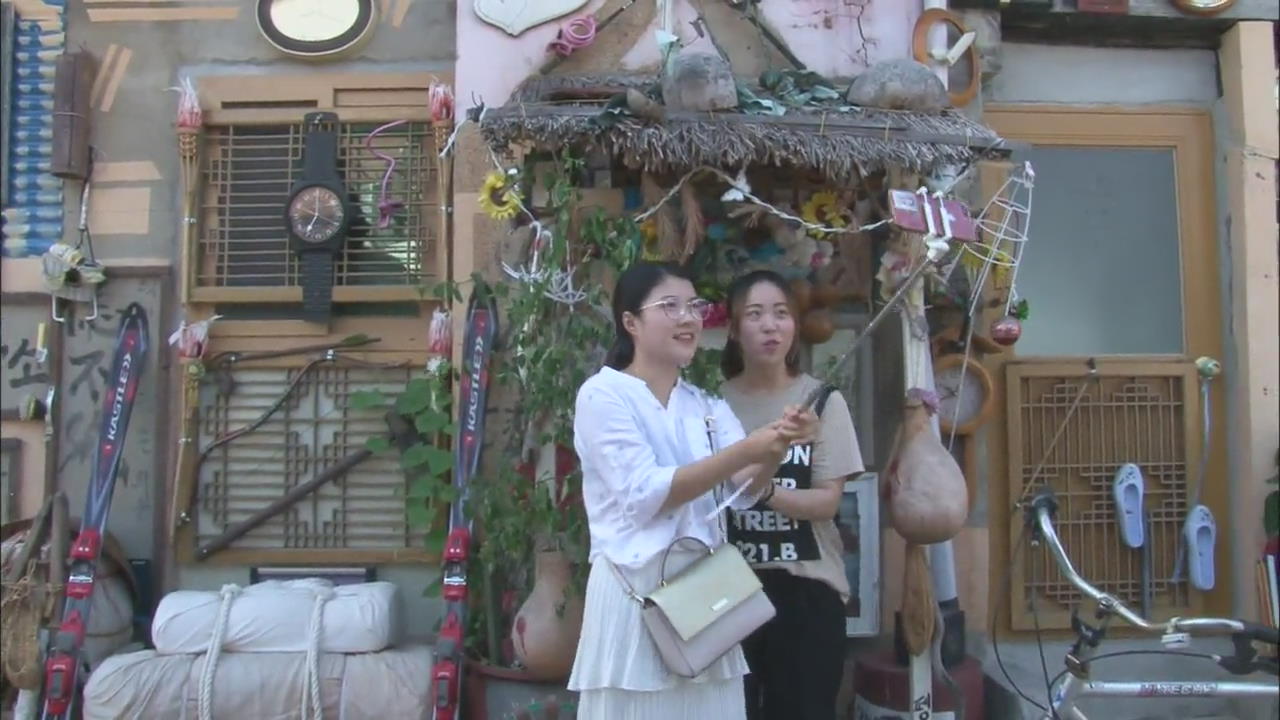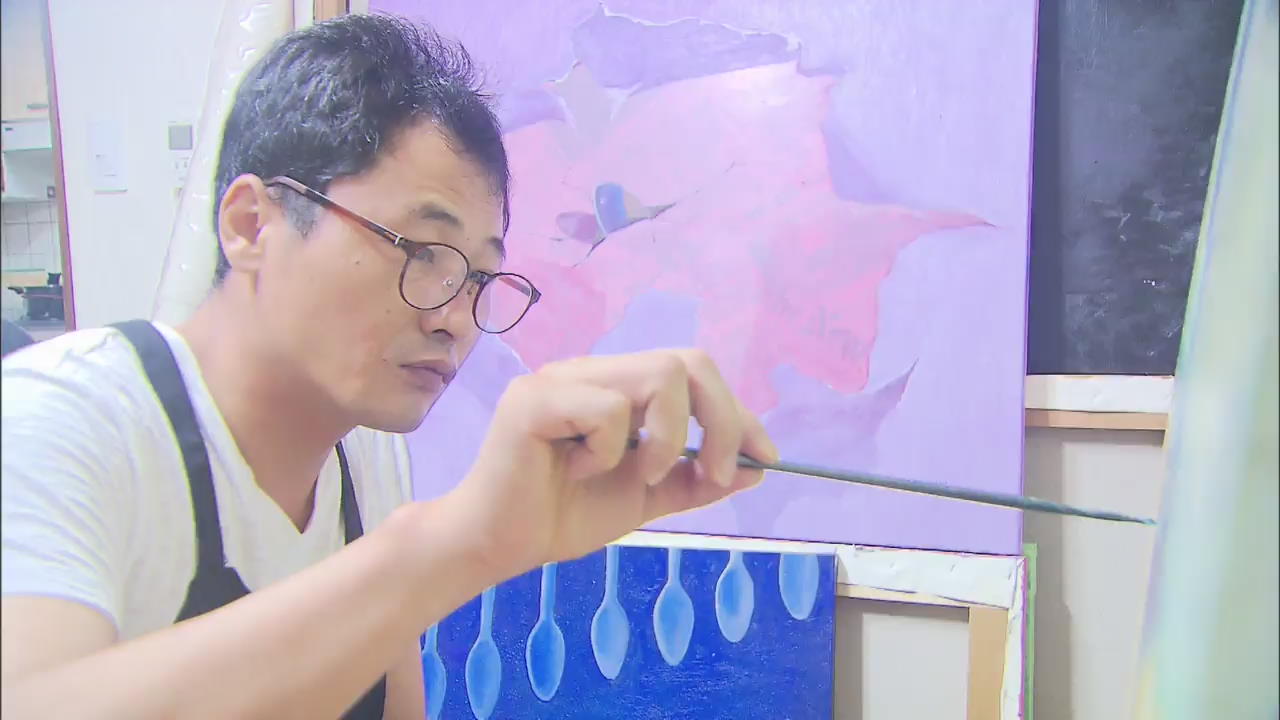Gwangju’s Yangrim-Dong
입력 2017.07.25 (14:15)
수정 2017.07.25 (14:27)
읽어주기 기능은 크롬기반의
브라우저에서만 사용하실 수 있습니다.
[Anchor Lead]
Today we take you to the southwestern city of Gwangju. In Gwangju, a village themed on penguins is now emerging as a popular tourist destination. Let's go to Yangrim-dong now.
[Pkg]
This is Yangrim-dong in Gwangju, a city encircled by green mountains. Low-rise traditional Korean housing hanok and exotic Western-style brick structures stand in harmony in an alley.
[Soundbite] Kang Yang-shin(Village Head of Yangrim-dong) : "There were many willow trees here in the past. The village's name originated from it. Many schools, hospitals and churches were built, following the arrival of missionaries in the early 1900s. Afterwards, the city's modernization began and a lot of cultural relics from that era are left."
An older hanok house is found at the end of an alley, past Gwangju's first church Yangrim Church. Built in 1899, this is the house of Lee Jang-woo, a renowned educator in Jeolla Province. The house is so valuable that it was designated as Gwangju's folk cultural asset No.1. A refreshingly green garden appears inside a tall gate. It is a Japanese-style garden. This is a typical upper-class house in the late Joseon Dynasty era.
[Soundbite] Ryu-Eui-jeong(Seoul Resident) : "It is amazing that there is a hanok, like this, in Gwangju."
A local specialty is served at this house. It is a stew of pork and a young green pumpkin. The sound of simmering is tempting. A complete table of unsophisticated but nice cuisine has been set. The stew has different charms from bean paste to kimchi stews.
[Soundbite] "I like the fresh smell of young green pumpkins."
With a full stomach, let's hit the road again for Yangrim-dong in southern Gwangju. The entire neighborhood resembles a large unique gallery with various penguin-shaped structures. Enjoying growing popularity, the village attracted 200-thousand tourists last year.
[Soundbite] Chinese Tourist : "I like that objects used by people were recycled as artworks and put on display."
How was the Penguin Village created?
[Soundbite] Kim Dong-kyun(Head of the Penguin Village) : "Many houses were left empty after roads were built and buildings were demolished. And then, they have been transformed into artworks in connection with the Yangrim-dong Modern Historical and Culture Village."
A three-minute-walk from the Penguin Village leads to Gwangju Sajik Park. A 13.7-meter observatory tower rises up. The top of the tower offers a panoramic view of the village and the city. In particular, a sunset glow hanging over the city is unforgettably beautiful,
[Soundbite] Park Jong-myon(Gwangju Resident) : "I like the panoramic, unblocked view."
A tour around Yangrim-dong offers opportunities to rediscover the historical and cultural breaths of the city.
Today we take you to the southwestern city of Gwangju. In Gwangju, a village themed on penguins is now emerging as a popular tourist destination. Let's go to Yangrim-dong now.
[Pkg]
This is Yangrim-dong in Gwangju, a city encircled by green mountains. Low-rise traditional Korean housing hanok and exotic Western-style brick structures stand in harmony in an alley.
[Soundbite] Kang Yang-shin(Village Head of Yangrim-dong) : "There were many willow trees here in the past. The village's name originated from it. Many schools, hospitals and churches were built, following the arrival of missionaries in the early 1900s. Afterwards, the city's modernization began and a lot of cultural relics from that era are left."
An older hanok house is found at the end of an alley, past Gwangju's first church Yangrim Church. Built in 1899, this is the house of Lee Jang-woo, a renowned educator in Jeolla Province. The house is so valuable that it was designated as Gwangju's folk cultural asset No.1. A refreshingly green garden appears inside a tall gate. It is a Japanese-style garden. This is a typical upper-class house in the late Joseon Dynasty era.
[Soundbite] Ryu-Eui-jeong(Seoul Resident) : "It is amazing that there is a hanok, like this, in Gwangju."
A local specialty is served at this house. It is a stew of pork and a young green pumpkin. The sound of simmering is tempting. A complete table of unsophisticated but nice cuisine has been set. The stew has different charms from bean paste to kimchi stews.
[Soundbite] "I like the fresh smell of young green pumpkins."
With a full stomach, let's hit the road again for Yangrim-dong in southern Gwangju. The entire neighborhood resembles a large unique gallery with various penguin-shaped structures. Enjoying growing popularity, the village attracted 200-thousand tourists last year.
[Soundbite] Chinese Tourist : "I like that objects used by people were recycled as artworks and put on display."
How was the Penguin Village created?
[Soundbite] Kim Dong-kyun(Head of the Penguin Village) : "Many houses were left empty after roads were built and buildings were demolished. And then, they have been transformed into artworks in connection with the Yangrim-dong Modern Historical and Culture Village."
A three-minute-walk from the Penguin Village leads to Gwangju Sajik Park. A 13.7-meter observatory tower rises up. The top of the tower offers a panoramic view of the village and the city. In particular, a sunset glow hanging over the city is unforgettably beautiful,
[Soundbite] Park Jong-myon(Gwangju Resident) : "I like the panoramic, unblocked view."
A tour around Yangrim-dong offers opportunities to rediscover the historical and cultural breaths of the city.
■ 제보하기
▷ 카카오톡 : 'KBS제보' 검색, 채널 추가
▷ 전화 : 02-781-1234, 4444
▷ 이메일 : kbs1234@kbs.co.kr
▷ 유튜브, 네이버, 카카오에서도 KBS뉴스를 구독해주세요!
- Gwangju’s Yangrim-Dong
-
- 입력 2017-07-25 14:01:58
- 수정2017-07-25 14:27:47

[Anchor Lead]
Today we take you to the southwestern city of Gwangju. In Gwangju, a village themed on penguins is now emerging as a popular tourist destination. Let's go to Yangrim-dong now.
[Pkg]
This is Yangrim-dong in Gwangju, a city encircled by green mountains. Low-rise traditional Korean housing hanok and exotic Western-style brick structures stand in harmony in an alley.
[Soundbite] Kang Yang-shin(Village Head of Yangrim-dong) : "There were many willow trees here in the past. The village's name originated from it. Many schools, hospitals and churches were built, following the arrival of missionaries in the early 1900s. Afterwards, the city's modernization began and a lot of cultural relics from that era are left."
An older hanok house is found at the end of an alley, past Gwangju's first church Yangrim Church. Built in 1899, this is the house of Lee Jang-woo, a renowned educator in Jeolla Province. The house is so valuable that it was designated as Gwangju's folk cultural asset No.1. A refreshingly green garden appears inside a tall gate. It is a Japanese-style garden. This is a typical upper-class house in the late Joseon Dynasty era.
[Soundbite] Ryu-Eui-jeong(Seoul Resident) : "It is amazing that there is a hanok, like this, in Gwangju."
A local specialty is served at this house. It is a stew of pork and a young green pumpkin. The sound of simmering is tempting. A complete table of unsophisticated but nice cuisine has been set. The stew has different charms from bean paste to kimchi stews.
[Soundbite] "I like the fresh smell of young green pumpkins."
With a full stomach, let's hit the road again for Yangrim-dong in southern Gwangju. The entire neighborhood resembles a large unique gallery with various penguin-shaped structures. Enjoying growing popularity, the village attracted 200-thousand tourists last year.
[Soundbite] Chinese Tourist : "I like that objects used by people were recycled as artworks and put on display."
How was the Penguin Village created?
[Soundbite] Kim Dong-kyun(Head of the Penguin Village) : "Many houses were left empty after roads were built and buildings were demolished. And then, they have been transformed into artworks in connection with the Yangrim-dong Modern Historical and Culture Village."
A three-minute-walk from the Penguin Village leads to Gwangju Sajik Park. A 13.7-meter observatory tower rises up. The top of the tower offers a panoramic view of the village and the city. In particular, a sunset glow hanging over the city is unforgettably beautiful,
[Soundbite] Park Jong-myon(Gwangju Resident) : "I like the panoramic, unblocked view."
A tour around Yangrim-dong offers opportunities to rediscover the historical and cultural breaths of the city.
Today we take you to the southwestern city of Gwangju. In Gwangju, a village themed on penguins is now emerging as a popular tourist destination. Let's go to Yangrim-dong now.
[Pkg]
This is Yangrim-dong in Gwangju, a city encircled by green mountains. Low-rise traditional Korean housing hanok and exotic Western-style brick structures stand in harmony in an alley.
[Soundbite] Kang Yang-shin(Village Head of Yangrim-dong) : "There were many willow trees here in the past. The village's name originated from it. Many schools, hospitals and churches were built, following the arrival of missionaries in the early 1900s. Afterwards, the city's modernization began and a lot of cultural relics from that era are left."
An older hanok house is found at the end of an alley, past Gwangju's first church Yangrim Church. Built in 1899, this is the house of Lee Jang-woo, a renowned educator in Jeolla Province. The house is so valuable that it was designated as Gwangju's folk cultural asset No.1. A refreshingly green garden appears inside a tall gate. It is a Japanese-style garden. This is a typical upper-class house in the late Joseon Dynasty era.
[Soundbite] Ryu-Eui-jeong(Seoul Resident) : "It is amazing that there is a hanok, like this, in Gwangju."
A local specialty is served at this house. It is a stew of pork and a young green pumpkin. The sound of simmering is tempting. A complete table of unsophisticated but nice cuisine has been set. The stew has different charms from bean paste to kimchi stews.
[Soundbite] "I like the fresh smell of young green pumpkins."
With a full stomach, let's hit the road again for Yangrim-dong in southern Gwangju. The entire neighborhood resembles a large unique gallery with various penguin-shaped structures. Enjoying growing popularity, the village attracted 200-thousand tourists last year.
[Soundbite] Chinese Tourist : "I like that objects used by people were recycled as artworks and put on display."
How was the Penguin Village created?
[Soundbite] Kim Dong-kyun(Head of the Penguin Village) : "Many houses were left empty after roads were built and buildings were demolished. And then, they have been transformed into artworks in connection with the Yangrim-dong Modern Historical and Culture Village."
A three-minute-walk from the Penguin Village leads to Gwangju Sajik Park. A 13.7-meter observatory tower rises up. The top of the tower offers a panoramic view of the village and the city. In particular, a sunset glow hanging over the city is unforgettably beautiful,
[Soundbite] Park Jong-myon(Gwangju Resident) : "I like the panoramic, unblocked view."
A tour around Yangrim-dong offers opportunities to rediscover the historical and cultural breaths of the city.
이 기사가 좋으셨다면
-
좋아요
0
-
응원해요
0
-
후속 원해요
0











![[Korea Snapshot] Taejongdea Recreation Area](https://news.kbs.co.kr/data/news/2017/07/25/3521909_100.jpg)

![[단독] 위성락 실장 “전작권 협상 카드 아냐”…차관 인선 발표](/data/layer/904/2025/07/20250713_krfuHu.jpg)



이 기사에 대한 의견을 남겨주세요.